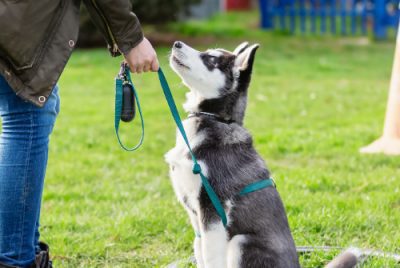Ultimate Guide: Top Ten Flea Prevention for Dogs
Post Disclaimer
We may earn a commission for purchases made using our links. Please see our Disclaimer to learn more.
Top Ten Flea Prevention for Dogs: Your Ultimate Guide
Key Highlights
- Fleas and ticks spread diseases to humans and animals, making flea prevention essential for your dog’s health. Various flea solutions are available, including natural essential oil collars, oral flea prevention pills, topical flea treatments, flea prevention shampoos, flea combs, homemade flea sprays, diatomaceous earth, flea repellent plants, ultrasonic flea collars, and prescription flea treatments from your vet.
- Natural essential oil collars are a great option for flea prevention. They use natural ingredients to repel fleas and ticks.
- Oral flea prevention pills are effective at killing fleas and preventing future infestations. They also protect against intestinal parasites and heartworm disease.
- Topical flea treatments and medications are applied directly to your dog’s skin and provide long-lasting protection against fleas and ticks.
- Flea prevention shampoos can be used regularly as part of your dog’s grooming routine to kill and repel fleas.
- Flea combs are useful for removing adult fleas and their eggs from your dog’s fur.
- Homemade flea sprays with vinegar and lemon can be made using natural ingredients to provide an extra layer of protection against fleas.
- Diatomaceous earth is a safe and effective home remedy for controlling flea infestations in your home.
- Flea-repellent plants in your garden can naturally repel fleas and ticks, providing additional protection for your dog.
- Ultrasonic flea collars emit ultrasonic waves that repel fleas and ticks, making them a convenient and non-toxic option for flea prevention.
- Prescription flea treatments from your vet are recommended for severe flea infestations and provide the most effective and targeted solution.
Introduction
Fleas are not just a nuisance for dogs but can pose serious health risks. These tiny parasites can transmit diseases like Lyme disease and cause discomfort to your beloved pet. To help you combat this common issue, we have compiled a list of the top ten flea-prevention remedies. Implementing these preventative measures lets you keep your furry friend flea-free and healthy. From natural essential oil collars to prescription treatments from your vet, there are various options to choose from based on your preferences and your dog’s needs. Understanding the importance of flea prevention is key to maintaining a happy and healthy relationship with your canine companion.
Top 10 Flea Prevention Solutions for Your Dog
Natural Essential Oil Collars, Oral Flea Prevention Pills, Topical Flea Treatments, Flea Prevention Shampoos, Flea Combs, Homemade Flea Sprays, Diatomaceous Earth, Flea Repellent Plants, Ultrasonic Flea Collars, Prescription Flea Treatments. These top ten flea prevention remedies offer a range of options to keep your dog flea-free. Essential oil collars use natural ingredients, while oral pills provide systemic protection. Topical treatments target adult fleas, and shampoos cleanse the coat. Combing removes pests, homemade sprays offer a DIY approach, and diatomaceous earth controls infestations. Repellent plants and ultrasonic collars add extra layers of defense, with prescription treatments available for severe cases. Choose the best flea prevention solution for your dog’s specific needs and lifestyle.
1. Natural Essential Oil Collars
Natural essential oil collars offer a holistic approach to flea prevention for dogs. These collars contain natural ingredients like essential oils that are known for their flea-repellent properties. The oils are slowly released to create a protective barrier around your pet, making it an effective, chemical-free option for flea control. In addition to repelling fleas, essential oil collars can help deter insects like ticks and mosquitoes, providing overall parasite protection for your furry friend. Pet owners who prefer natural products for their pets often opt for these collars as they are considered safe for both pets and humans, minimizing the risks of side effects associated with chemical treatments.
2. Oral Flea Prevention Pills
Oral flea prevention pills are a convenient and effective way to protect your furry friend from pesky fleas. These pills contain active ingredients circulating in your dog’s bloodstream, killing fleas when they bite. They are particularly beneficial for pet owners who struggle with topical treatments or have dogs with sensitive skin. Additionally, oral preventatives are often used in conjunction with tick prevention to provide comprehensive parasite protection. It is crucial to consult your vet before starting any oral products, especially for very young puppies or dogs with underlying health conditions. These pills are an excellent choice for pet parents seeking an easy and reliable method to keep their dogs flea-free.
3. Topical Flea Treatments and Medications
Topical flea treatments and medications provide effective flea prevention by targeting adult fleas and preventing future infestations. These treatments typically come in the form of spot-on solutions applied directly to your dog’s skin, usually between the shoulder blades or at the base of the tail. They contain active ingredients that kill fleas on contact and provide lasting protection. Topical solutions are easy to apply and offer a convenient safeguard for your furry friend against fleas. It’s essential to consult your vet before choosing a topical flea treatment to ensure it suits your dog’s specific needs.
4. Flea Prevention Shampoos
Flea prevention shampoos are a convenient way to keep your dog free from pesky fleas. These shampoos cleanse your dog’s coat and eliminate adult fleas and their eggs upon contact. Look for shampoos with natural ingredients like essential oils for a gentle yet effective solution. Regularly using flea-prevention shampoos can help maintain a flea-free environment for your pet. Ensure you follow the instructions on the product label and avoid using human shampoos, as they may be too harsh for your dog’s skin. Combine using flea prevention shampoos with other preventive measures for comprehensive flea protection.
5. Flea Combs for Daily Use
Regular combing with flea combs is a proactive approach in preventing flea infestations. These combs have fine teeth that can catch adult fleas, eggs, and flea dirt between your dog’s fur. By combing daily, you can physically remove fleas and monitor the effectiveness of your flea prevention methods. Flea combs are particularly useful for dogs with sensitive skin who may react to topical treatments. This method is also safe for very young puppies who cannot yet use other forms of flea prevention. Remember to concentrate on areas like the base of the tail and shoulder blades where fleas tend to hide. Consistent combing can help early detection and control of flea populations on your beloved pet.
6. Homemade Flea Sprays with Vinegar and Lemon
Dealing with fleas naturally? Homemade flea sprays with vinegar and lemon are popular among pet owners. These natural products are effective in repelling fleas due to their natural ingredients. Vinegar is a repellent that disrupts the flea’s lifecycle, while lemon adds a citrusy scent that fleas despise. Mix equal parts of water and vinegar with a few drops of lemon essential oil to create a homemade flea spray. This solution can be sprayed directly on your dog’s fur, avoiding sensitive areas like the face. Remember to consult your vet before using homemade remedies, especially if your dog has sensitive skin or underlying health conditions.
7. Diatomaceous Earth for Flea Control in the Home
Diatomaceous earth is a natural remedy for flea control in your home. This powdery substance dehydrates and ultimately kills fleas and insects by damaging their exoskeletons. To use it effectively, sprinkle diatomaceous earth evenly on carpets, pet bedding, and any areas where fleas may hide. Leave it for about 48 hours and then vacuum thoroughly to remove dead fleas and the powder. Diatomaceous earth is safe for pets and humans, but make sure to opt for food-grade quality. Regular application can help in maintaining a flea-free environment without the use of harsh chemicals. It’s a pet-friendly option that can contribute to a healthier living space.
8. Flea Repellent Plants in Your Garden
Flea repellent plants in your garden are a natural and effective way to combat fleas. Plants such as lavender, mint, and chrysanthemums contain natural oils that are known for their flea-repelling properties. These plants not only beautify your garden but also act as a deterrent to pesky fleas. By strategically placing these plants in your outdoor space, you can create a natural barrier against fleas and reduce the likelihood of infestations. Integrating flea-repellent plants into your garden is a sustainable and eco-friendly approach to flea prevention for your beloved pets. Embracing nature’s remedies can enhance your flea prevention efforts while adding a touch of greenery to your surroundings.
10 Great Plants That Repel Fleas and Ticks – The Practical Planter
Natural Flea Repellents: Best Plants to Repel Fleas (everythingbackyard.net)
9. Ultrasonic Flea Collars
Ultrasonic flea collars are an innovative method for repelling fleas using high-frequency sound waves that are imperceptible to humans and pets. These collars emit vibrations that disturb fleas, preventing them from latching onto your dog’s fur. Unlike traditional collars, ultrasonic flea collars offer a chemical-free solution for flea prevention, making them ideal for pet owners concerned about potential side effects from topical or oral treatments. The technology targets adult fleas by disrupting their communication and reproductive cycles. While ultrasonic flea collars may not eliminate existing infestations, they can be valuable to your pet care routine in deterring future flea problems.
10. Prescription Flea Treatments from Your Vet
Prescription flea treatments from your vet effectively combat stubborn flea infestations. These medications often contain potent ingredients that target adult fleas and prevent their reproduction. Veterinarians may recommend products such as Simparica Trio, which provides comprehensive protection against fleas and ticks. It’s crucial to follow your vet’s instructions precisely when using prescription flea treatments to ensure optimal results and minimize potential side effects. Remember to promptly discuss any concerns or observations with your vet to tailor the treatment to your dog’s needs. Consulting with a professional ensures the right flea preventative is chosen, offering safe and efficient parasite protection for your beloved pet.
Understanding Fleas: Lifecycles and Risks
Fleas not only irritate your dog but also pose health risks. Understanding the lifecycle of a flea is crucial in combating them effectively. Fleas can cause severe discomfort and allergic reactions and transmit diseases like Lyme disease. These tiny parasites have a complex lifecycle, passing through egg, larva, pupa, and adult stages. Recognizing the environmental conditions favorable for each stage can aid in prevention. Adult fleas can lay up to 50 eggs daily, rapidly exacerbating infestations. Regularly grooming your pet can help detect fleas early. Educating yourself about the risks associated with fleas can empower you to protect your furry friend effectively.
How Fleas Affect Your Dog’s Health
Fleas can wreak havoc on your dog’s health, leading to various issues beyond irritating itching. These pesky parasites can transmit diseases like Lyme disease and cause anemia due to blood loss, especially in smaller breeds. Additionally, fleas can trigger allergic reactions in dogs, resulting in skin problems such as hair loss and inflammation. Constant scratching from flea bites can lead to secondary infections and discomfort for your furry friend. Furthermore, flea infestations can introduce other parasites like tapeworms, compounding the health risks for your pet. Tackling fleas promptly is crucial to safeguard your dog’s well-being and prevent these potential health complications.
The Lifecycle of a Flea: Understanding Your Enemy
Fleas go through four stages in their lifecycle: egg, larva, pupa, and adult. Understanding this lifecycle is crucial for effective flea prevention. Adult fleas lay flea eggs and can be found on your dog’s fur or in their environment. These eggs then hatch into larvae, which feed on organic matter such as flea dirt and skin debris. The larvae then spin cocoons and enter the pupal stage, remaining protected until they emerge as adult fleas. Adult fleas feed on your dog’s blood and reproduce, starting the lifecycle all over again. By targeting all stages of the flea lifecycle, flea prevention methods can effectively control and prevent infestations.
Choosing the Right Flea Prevention Method
When it comes to choosing the right flea prevention method for your dog, there are several factors to consider. First, you must consider your dog’s age and weight. Some flea prevention methods are not suitable for puppies or very small dogs. It’s also important to consider your dog’s existing health conditions, as some treatments may be contraindicated. Lastly, it’s important to choose a convenient and easy method to administer, whether it’s a pill, a topical treatment, a collar, or a shampoo.
Factors to Consider When Selecting Flea Prevention
When selecting a flea prevention method for your dog, there are several factors to consider. First, consider your dog’s age and weight. Some treatments are only suitable for adult dogs, while others can be used on puppies as young as eight weeks old. Next, think about any existing health conditions your dog may have. Some dogs have sensitive skin or allergies, so choosing a flea prevention method that won’t cause adverse reactions is important. Lastly, consider the effectiveness of the treatment. Different products target different types of fleas, so choosing the right flea prevention method for your specific needs is important.
The Pros and Cons of Natural vs. Chemical Treatments
When it comes to flea prevention, pet owners have the option of choosing between natural remedies and chemical treatments. Natural remedies often use ingredients such as essential oils to repel fleas, while chemical treatments contain synthetic ingredients that kill and repel fleas. Natural remedies can be effective to some extent, but they may not provide the same level of protection as chemical treatments. Chemical treatments, on the other hand, are more potent and can provide long-lasting protection. However, they may also have potential side effects, such as skin irritation or allergic reactions. It’s important to weigh the pros and cons of natural vs. chemical treatments and choose the best option for your dog’s needs.
Application Tips for Flea Treatments
Proper application of flea treatments is essential for their effectiveness. When applying topical medications, it’s important to part your dog’s fur and apply it directly to their skin, usually between the shoulder blades. Be sure to follow the instructions on the packaging and avoid applying the treatment near your dog’s eyes, mouth, or nose. Ensure your dog completely swallows the pill or chewable tablet for oral medications. If using a flea collar, adjust it to fit snugly around your dog’s neck without being too tight. Following these application tips will help ensure the flea treatment is applied correctly and effectively.
Best Practices for Applying Topical Medications
When applying topical flea medications, it is important to follow best practices to ensure their effectiveness. Start by parting your dog’s fur to expose their skin, typically between the shoulder blades or at the base of the tail. Apply the medication directly to the skin, spreading it evenly. Avoid applying the medication near your dog’s eyes, mouth, or nose. After application, wash your hands thoroughly to prevent any potential contact with the medication. It’s also important to monitor your dog for any signs of irritation or adverse reactions. If you notice any unusual symptoms, consult your veterinarian. Following these best practices will help ensure the topical medication is applied correctly and effectively for flea prevention.
Tips for Administering Oral Flea Medications
Administering oral flea medications to your dog requires some careful handling. Start by making sure your dog is in a calm and relaxed state. For chewable tablets, offer the tablet to your dog as a treat or hide it in their food. Make sure your dog chews the tablet completely and swallows it. Use a syringe or dropper to measure the appropriate dosage and administer it directly into your dog’s mouth for liquid medications. It’s important to follow the instructions provided by the manufacturer and consult your veterinarian if you have any concerns or questions. Note that some oral flea medications are unsuitable for young puppies, so check the age requirements before administering any medication.
Maintaining a Flea-Free Environment
Preventing fleas in your dog goes beyond just treating your pet. It’s important to maintain a flea-free environment in your home as well. Regular cleaning routines can help prevent flea infestations. Vacuum your carpets, rugs, and furniture regularly, paying special attention to areas where your dog spends a lot of time. Wash your dog’s bedding and any other fabric items they come into contact with. Additionally, it’s important to treat your home and yard with flea control products to eliminate any existing fleas and prevent reinfestation. Maintaining a flea-free environment can help protect your dog from fleas and reduce the risk of infestations.
Regular Cleaning Routines to Prevent Flea Infestations
Regular cleaning routines are essential for preventing flea infestations in your home. Start by regularly vacuuming your carpets, rugs, and furniture, paying close attention to areas where your dog spends a lot of time. Empty the vacuum bag or canister outside to prevent fleas from reinfesting your home. Wash your dog’s bedding and any other fabric they come into contact with using hot water and a detergent. This will help kill any fleas or flea eggs that may be present. Additionally, sweeping and mopping your floors regularly is a good idea to remove any flea dirt or eggs that may have fallen. Regular cleaning can help prevent flea infestations and keep your home flea-free.
Safe Use of Flea Treatments Around Children and Other Pets
When using flea treatments around children and other pets, it’s important to prioritize safety. Follow the instructions provided by the manufacturer and never exceed the recommended dosage. Keep flea treatment out of reach for children and store it securely. If applying a topical treatment, make sure to wash your hands thoroughly after application to prevent accidental ingestion. If using a flea collar, ensure it fits snugly around your dog’s neck but is not too tight. It’s also important to be aware of any applicable laws or regulations regarding the use of flea treatments around children and pets. By prioritizing safety, you can ensure your dog’s and your family’s well-being.
Conclusion
In conclusion, maintaining a flea-free environment for your dog requires a comprehensive approach that includes prevention methods, understanding the lifecycle of fleas, and choosing the right treatment. You can effectively protect your furry friend from these pesky parasites by incorporating natural remedies like essential oil collars and flea-repellent plants or prescription treatments when necessary. Remember to follow proper application tips and maintain a clean living space to prevent infestations. Prioritizing your dog’s flea prevention ensures their health and comfort and promotes a happy and harmonious pet-owner relationship.
Frequently Asked Questions
What Are the Signs My Dog Has Fleas?
Some common signs that your dog may have fleas include excessive scratching, hair loss, and the presence of flea dirt (small black specks that resemble pepper) on your dog’s fur. If you notice any of these signs, it’s important to take action to eliminate the fleas and prevent further infestations.
How Often Should I Treat My Dog for Fleas?
Your dog’s frequency of flea treatment depends on several factors, including the flea lifecycle in your area and your veterinarian’s recommendation. To ensure continuous protection, your veterinarian recommends treating your dog for fleas every 30 days. However, your veterinarian may recommend more or less frequent treatments based on your dog’s needs.
Can My Dog Still Get Fleas After Treatment?
While flea treatments are effective at killing and preventing fleas, it is still possible for your dog to get fleas after treatment. Dogs can be reinfected with fleas if they come into contact with infested environments or other animals. Additionally, some fleas may develop resistance to certain treatments. Environmental factors, such as a heavily infested yard, can also contribute to flea infestations. It’s important to continue using flea prevention methods and address any environmental factors to reduce the risk of fleas.
Are There Any Side Effects to Flea Treatments?
Some flea treatments may have potential side effects, including skin irritation, allergic reactions, or gastrointestinal upset. It’s important to follow the instructions provided by the manufacturer and monitor your dog for any adverse reactions. If you notice any unusual symptoms or side effects, consult your veterinarian. Some dogs may also have a lower tolerance for certain medications, so choosing the right flea treatment for your dog’s needs is important.
How Can I Naturally Prevent Fleas on My Dog?
Natural remedies can be used to prevent fleas on your dog. Some effective options include using essential oils like lavender or lemon, creating a flea-repellent spray with vinegar and water, and feeding your dog a diet rich in garlic or apple cider vinegar. Regular grooming, including brushing and combing your dog’s fur, can also help prevent flea infestations.
What to Do If Flea Treatments Don’t Work?
If flea treatments don’t work for your dog, it is important to consult with a veterinarian. They can help determine the underlying cause of treatment failure and provide alternative options. This may include trying a different type of flea and tick medicine, using additional preventive measures, or addressing any underlying health issues that may be contributing to the problem.






Comments are closed.